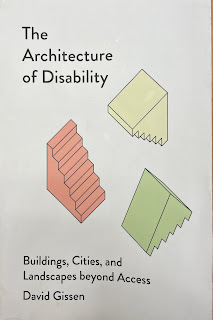The Architecture of Disability
by David Gissen
University of Minnesota Press, 2022
ISBN: 978-1-5179-1250-5
(Amazon)
Purchased for $22.74, Read August 2023
"When the Jews left Egypt, almost all of them were disabled. How did that happen to be? They had been working with bricks and clay, climbing to the tops of buildings. Those doing the construction work would get to the upper levels of the building and a rock would fall on them and cut off their hands, or a beam or some clay would get into their eyes, blinding them. That’s how they became disabled." (Numbers Rabbah, Naso 7:1)
In the final chapter of The Architecture of Disability, the author writes that "three-quarters of career construction workers in the United States have sustained some type of permanent impairment from their work. Recent historians of architecture have emphasized the risks and impairments experienced by those who build works of architecture - a generally neglected topic within architectural history and the histories of modernism." This point, along with a discussion about construction work done by (and for) disabled veterans, is an example of the next-level accessibility and awareness the author would like to see in the built environment.
In the last 30+ years, building code has made architecture far more accessible than ever before. However, David Gissen lays out several ways in which architecture can be more inclusive to the disabled. Rather than list ways in which buildings need to be more accessible, he argues for architecture that represents disability proudly.
1) Architecture is often described in terms of an able human body, with proportions and symmetry matching a "standard" body. This, Gissen argues, excludes disabled people. In different chapters, he suggests preserving ruined objects in states of disrepair, advancing a more Modern aesthetic with asymmetric design, planting tree species that are gnarled, and having buildings with prominent ramps as design components.
2) Monuments built hundreds of years ago, and certain public spaces like the much-maligned Vessel, cannot properly accommodate the disabled, and it is not enough to try and provide accessibility to them. Their very designs and the importance we ascribe them shuts out disabled people. In some cases, monuments were more accessible in their original state, as with the Acropolis, which had an elaborate system of ramps, or cathedrals like Saint Denis, which served many impaired pilgrims hoping for cures.
3) Environmental conditions in buildings, like temperature and acoustics, are geared toward "standard" bodies and are often not comfortable to people with disabilities.
4) Gissen raises the issue of disabilities caused from the construction industry, as I alluded to in the quote above.
The parts of this book which I found most interesting were those that dealt with historical facts, whether access to monuments, hydrological systems, or examples of construction work done by disabled veterans. Most of the design suggestions, however, seem far-fetched, unreasonable, and excessive. Nonetheless, the book does paint an interesting and valuable perspective which able architects may not otherwise consider.

Comments
Post a Comment